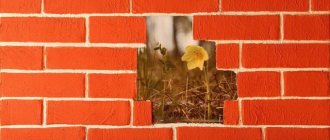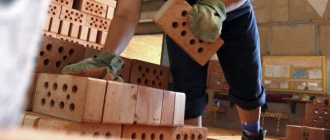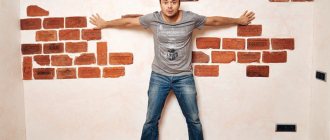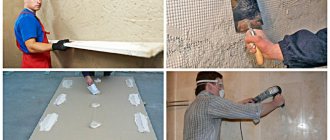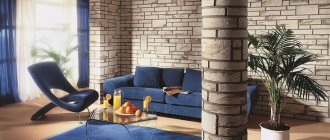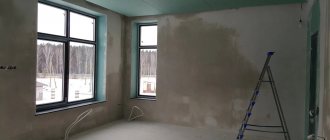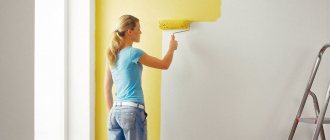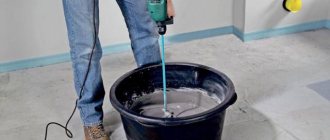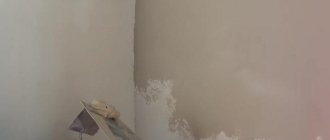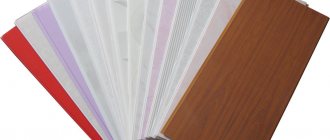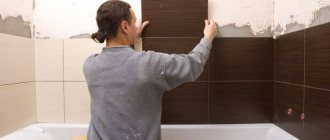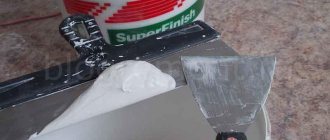You can make an imitation of a brick wall yourself in so many ways that we don’t even know which one to start with. We will try to describe a variety of techniques and approaches, and readers will choose the appropriate option themselves. In any case, the point is that when applying plaster, a special template made by yourself is used. It is recommended to add strong binders, such as tile adhesive, to typical facing materials. This ensures excellent adhesion of the plaster. In addition, quick-hardening materials should not be used. Let's see how an imitation of a brick wall is performed in practice.
Masonry imitation process
Features of simulating a brick wall with your own hands
You can make an imitation of a brick wall yourself in so many ways that we don’t even know which one to start with. We will try to describe a variety of techniques and approaches, and readers will choose the appropriate option themselves. In any case, the point is that when applying plaster, a special template made by yourself is used. It is recommended to add strong binders, such as tile adhesive, to typical facing materials. This ensures excellent adhesion of the plaster. In addition, quick-hardening materials should not be used. Let's see how an imitation of a brick wall is performed in practice.
Features of the work
When working with plaster, a beginner may encounter a number of difficulties. Moreover, if the construction work is not just finishing in nature, but serves for decoration. Creating a “brick” design has its own characteristics and advantages.
The main feature is its aesthetic appearance and relatively low costs. Such a coating looks very original and unusual, but it cannot be said that the execution of these works is too complicated.
Template for imitation brickwork
Anything can serve as a template for simulating brickwork. But, in general, these items can be divided into two classes:
In practice, there are also hybrid variations that use one and the other type of template. In this case, the outer frame is made of wood. Imitation of ligating brickwork is done with masking tape stretched inside. Obviously, such a pattern cannot be too large. Otherwise, it will not only be difficult for builders to move it from place to place, but also great difficulties will arise when passing jagged sections of the wall. Builders get out of the situation as follows:
The builder walks around with such a frame and, row by row, process the entire surface of the wall until they get an imitation of a brick wall made of plaster. The advantage of this solution is that it is also possible to work with quickly hardening solutions, like gypsum plaster. During the time that the builder covers a quarter square meter of the wall with the mixture, it will not have time to dry. Due to this, the master has greater flexibility in choosing the material. At the same time, one serious drawback is noticeable. The fact is that when applying the solution over the masking tape, you literally have to tear out the frame from under the plaster. This is fraught with damage to the shape of future bricks. Some may think that the wavy areas of the edges imitate clinker well, but other craftsmen will not like this effect.
That's why we recommend assembling the entire template from thin slats. Its shape will exactly repeat the design already discussed with one exception. The masking tape will also be replaced with wooden slats. In this case, the slightest gaps between the planks can cause some masonry defects. But, as we will see later, this is not so important. The main thing is to securely fasten the planks relative to each other so that the template does not move around.
Finally, by working with only masking tape and no wood strips, the template is created directly on the wall. To do this, an arbitrary area is painted with the desired design. And immediately we see the first advantage of such a solution. Dressing does not have to be regular. We can create both interlocking and longitudinal masonry patterns. Moreover, it becomes possible to imitate rough stones quite accurately. Previous, pre-created templates did not allow you to do anything like this. The imitation of brickwork on the wall turns out to be more natural.
dry waterproofing for bathroom floors
At the same time, masking tape has a couple of significant disadvantages. If the object is large, then pasting the wall will take a lot of time and a large amount of tape will be spent. This is completely unacceptable in professional planned development. But for some amateurs and apartment owners, this method may seem simpler. Because it requires a minimum of preparatory work, the process of applying the mixture itself is not very complicated. The second disadvantage is that the solution should not harden too quickly. Otherwise, it will be simply impossible to tear out the masking tape from under it without damaging the pattern of the brickwork.
Stencil design on the wall
Advice! To practice, first apply paint using a stencil to a piece of wallpaper or whatman paper. This will help you get the hang of it, and will also give you the opportunity to determine which color suits best (to do this, hold the sample up to the wall).
Create a stencil template from construction paper
- Prepare the surface: it must be clean and dry.
- Next, use a simple pencil to mark the location of the future drawing on the wall. For this purpose, you can use a level or a simple ruler.
- Then attach the stencil using tape or special stencil spray adhesive. The second option is preferable, since when tearing the treated stencil from the wall there is no danger of tearing off a piece of paint along with it. In addition, after you remove the stencil, the glue will not leave the slightest trace on the surface.
DIY Stencils
Position and secure the stencil on the wall
- Then comes the turn of coloring. Use a small amount of paint on the brush to prevent it from flowing under the stencil . It is best to hold the brush at a right angle to the wall and “drive” the paint.
Advice! If you are using a thin brush and working on small details, do not use the stamping method, but rather paint over the design in an up and down motion. When applying aerosol paint, place the can at a distance of at least 30 cm from the surface. When working with a sponge, the first two or three prints should be made on a “draft” - a piece of wallpaper or whatman paper to remove excess paint. When applying a design with a paint roller, then paint the unpainted corners and small details separately with a thin brush.
Original handmade wall decor
Stencil designs in the interior are an excellent opportunity to add original decor to the atmosphere of the room, which you can create with your own hands.
Sources:
https://happymodern.ru/trafarety-dlya-sten-svoimi-rukami-50-foto-tonkosti-i-sekrkty-texniki/
The process of applying plaster imitating brickwork
Let's first consider the option with masking tape, as it is the simplest. At the initial moment of time, you need to correctly mark the wall. The easiest way to do this is with a ruler and a building level. It’s also a good idea to get a strip thick enough so that the contour builder can easily be applied to its end. A regular building level with bubbles will do. The process is simplified by the fact that you only need to draw exactly one line with the rail. We will plot all other horizontal lines from the first one up and down using a ruler. Once the process is completed, you can begin simulating ligation of sutures. When laying out the horizontal lines, do not forget to take the trouble to set aside the thickness of the joint in addition to the height of the bricks.
The ligation of the seams is carried out either regularly with one brick overlapping exactly half of the other, or in a random order. Thus, a perfect imitation of a brick wall in the interior is performed. That is, as was written above, the master has greater flexibility to choose the appropriate aesthetic solution. Once the marking of the wall is completed, the process of gluing the tape begins. First of all, horizontal lines are laid out along the entire length. Vertical dressing seams are glued on top. This ensures the creation of a single template from masking tape, which is then very easily torn out from under the applied construction mixture.
The surface is primed before laying the plaster. If waterproofing is required, you must select the appropriate composition at a hardware store. The same applies to the fight against fungus and rodents. Next you need to act according to the instructions for the selected type of plaster. It is strongly recommended to add tile adhesive there to increase viscosity. An even layer of plaster is applied over the template. There is no need to rub this layer or specially level it. The waviness of the surface imitates brickwork even better.
While the mixture has not dried, the tape template must be carefully pulled out. At the same time, the seams remain almost completely clean. Surely many people will want to paint the resulting masonry in some color. A composition made from a range of terracotta or sand-lime bricks is suitable for this. After the wall has dried, you need to use a special tile grout for the seams. The color is chosen according to your own preferences.
Working with a frame template is much more subtle. The process starts from any angle. This is usually the bottom edge. Section by section, the builder goes through the entire wall. The jumpers with masking tape also end up under the plaster layer. In this case, an additional bonus is that you can imitate the natural color of the seams. Here's how it's done. A thin primer layer is applied under the main layer of plaster. A template is applied on top, and then all the work is done in the same way as already indicated above. The tape is carefully removed from under the main plaster, leaving the seams almost empty. But unlike the previous case, after drying these places will have the color of the building mixture. Therefore, all that remains is to paint the ends of the bricks.
wardrobe on a semicircular balcony
The whole problem is not to stain the seams. It is clear that the easiest way is to stick the notorious masking tape there. But this will not be the cheapest option. That is why we consider both of the above methods of making templates to be non-ideal. It would be much better to make a pattern from wooden slats, and below we give reasons why readers can understand all the nuances themselves:
This completes our instructions for simulating brickwork using plaster.
Source
Choosing a drawing technique
Original wall decor with painted cats
Advice! If during application the putty does not lie flat enough and sloppy edges are formed, do not worry: all defects can be corrected with sandpaper.
- Anti-stencil. Unlike other types of stencils, during the creation of which paint is applied inside the design, anti-stencil requires that a small area and beyond its borders be painted over. This helps achieve a glowing effect. In this case, spray paint is usually used. Please note: to create an anti-stencil, the part of the design that is usually thrown away is used - it is called a clipping. It is glued to the surface and spray paint is applied over it.
Original drawing in the bathroom, applied using a stencil
Delicate floral print on a blue wall in the bedroom
Symmetrical drawing on the wall of the room
READ How to cover wooden walls with plastic panels
Making a “Brick Wall” stencil with your own hands
This week I saw a wonderful notebook with voluminous decor on the Internet. And I was inspired to try working with a stencil. There were only butterflies and dinosaurs at work, so I had to use my wits! Armed with a new prototyping knife, I decided to create my own template! Perhaps many people make their stencils this way, but maybe my method will be useful to someone.
Materials for work:
— folder for documents;
- a picture with a stencil printed on a printer;
- cutting mat or board;
1. First of all, we look for a suitable stencil picture on the Internet (I already have a huge selection). We print on a b/w printer.
2. The document folder must be thick. Cut off the gluing area (mine is at the bottom). We open it like a book.
3. Take some kind of backing (I recommend a piece of plywood or plank for those who don’t have a special mat for cutting). First we put a printout with a stencil, then a page of a plastic folder. Carefully cut through the cells with a knife. I don’t like to repeat the design exactly, and therefore I deliberately change the shape of the cells or the distance between them.
4. Using scissors, we cut out our new stencil, leaving margins for further convenience.
5. Now we need to try it out! I took a frame blank, applied stencils and applied paste using cardboard.
6. After drying, a good clear relief was obtained! I was pleased with the result, which means the experiment was a success!
Creative mood and excellent results to everyone!
Source
Advantages and disadvantages
As for the advantages of this type of finishing work:
- high strength . The hardened plaster material has high strength, which prevents abrasion and mechanical damage;
- ease of execution . Even a beginner in the field of repair and design can do this type of finishing work. Therefore, the creation of such a wall can be accomplished without prior preparation and training;
- weight . If we compare the weight of the plaster coating and real brick, then the second option is much heavier and more difficult to work with than plaster;
- practicality _ The material does not require any additional maintenance;
- color . If a builder decides to make bricks black or green, then he does not need to look for a suitable brick; he can use paint.
Thus, finishing work with plaster is much easier and better than laying real brick.
What are stencils for plaster and why are they needed?
The stencil is used to decorate walls with plaster on any surface. The decoration turns out to be original, sophisticated, and the room is transformed into a comfortable place with an unusual style.
A stencil is an artificial masonry that creates a decorative pattern that protrudes above the main surface. Drawings can be different, with single or repeating elements. The template can be made with your own hands or purchased in a store. It is permissible to decorate the walls in different styles.
DIY stencil templates for decorative plaster have the following advantages:
To obtain a three-dimensional image, use a thick plaster mixture. Raised decorative patterns can be painted on a vertical, horizontal or sloping surface.
Finishing
After the brickwork has dried, finishing is carried out. To do this, the wall is primed with a brush.
- The entire brick wall is covered with paint and varnish material;
- After the paint has dried, the seams are painted. This is done using a small brush.
- For additional protection and aesthetics, you can coat the painted surface with acrylic varnish.
The color of the seams and bricks is chosen independently, but for a more realistic effect, use the “brick” color.
What to make a stencil for plaster from
Impressions on slightly dried plaster can be made using a special shaped roller. Thanks to the templates, three-dimensional pictures, protruding patterns, and unique layers are drawn on the walls.
external finishing of the balcony with corrugated sheets
A stencil for plaster can be made from paper, plastic or silicone.
The paper version is printed on a printer or drawn by hand, cut out according to ready-made patterns. Such templates are attached to the walls with tape and plaster is applied. They have a minimal cost, but are disposable.
Plastic stencils can be cut from bottles or other packaging. The selected picture is transferred to plastic and cut out with a stationery knife. Such templates are attached to the walls with special glue.
The simplest and most reliable stencil is the silicone version. The picture is poured onto a sheet of paper with silicone glue. After complete drying, the paper is removed, and the resulting reusable product is used to decorate the walls.
A mold for gypsum plaster will allow you to decorate in a short time
Types of stencils
A ready-made stencil can be purchased at a building materials store. But it’s cheaper to do it yourself. The matrix can be ordered at a printing workshop. Specialists will print it on a plotter and laser cut it.
The following types of stencils are distinguished:
- Paper - you can make them yourself from paper or cardboard. Pictures are often taken from the Internet or cut out from magazines. The cost of the products is minimal. But they are disposable and do not provide the opportunity to display three-dimensional images on the walls.
- Plastic products are considered reusable. Their thickness is on average up to 5 mm. Can be purchased at any hardware store.
- Silicone or rubber templates are durable and easy to attach to the wall. They allow you to make a complex design with different carved details.
It is better to use transparent templates that allow you to control the application of plaster during work.
How to make a stencil for decorative plaster with your own hands
You can make a transparent template yourself from a regular plastic A4 paper folder. The manufacturing instructions are as follows:
A drawing that is too large is divided into several parts. A separate template is made for each element. All the resulting fragments are carefully connected to each other on the wall.
A stencil that is too large is also cut out on a roll of thin insulation.
Reusable plastic stencils for decorative brick plaster
Brick stencils for textured plaster are cut out on thin plastic or linoleum.
The template should have brick dimensions of 25x6.5 cm
Creating imitation brickwork:
The seams can also be slightly tinted with a lighter or darker color than the shade of the simulated bricks.
Silicone stencils for volumetric decorative plaster
The silicone form is made from nitric acid, which is added to the nitrogen chips so that it quickly dissolves. The finished mixture is added to the catalyst. The solution has a rubber-like consistency.
The silicone stencil has a plastic shape, is resistant to mechanical stress, moisture and is completely safe
The silicone mold is made as follows:
Paper stencils for decorative plaster
Thick cardboard or thin plastic is used as a base for the stencil. The selected design is applied to it with a pencil. The pattern is cut out using a knife along the drawn lines. It is important not to damage the internal jumpers.
Paper options for applying decorative patterns are the easiest to use; they are glued to the walls and applied with plaster.
Tulle stencil for decorative plaster
To make a stencil that looks like crocodile skin for decorative plaster, you need to prepare acrylic putty, quartz primer, dyes, several meters of tulle or suitable fabric.
Steps for creating patterns on walls using tulle stencils:
The patterns on the wall are fixed with acrylic varnish, slightly diluted with mother-of-pearl enamel
Where to start: preparing materials
Decide on a pattern that will serve as the basis. The pattern should be selected based on the overall style of the room. Thus, abstract or geometric images will look much better in a high-tech living room than in a rococo room.
Images of birds and animals can be painted on the walls
Advice! Patterns for stencils can be any, but it is better to avoid designs with too small details: there is a high probability that the paint will flow beyond the boundaries of an element that is too small. In addition, it is quite possible that from a distance the small details of the design will look illegible and sloppy.
When the drawing is ready, you will need to decide on the stencil material. Most often, thick cardboard or plastic is used. These materials are dense enough to avoid accidental ruptures of the thin partitions between the details of the design. In addition, they do not bleed through paint, become wet, or curl up. You can also use paper, but in this case it is recommended to laminate the finished stencil - this will help protect against paint absorption and will allow you to use it more than once.
The wall in the nursery is decorated using a stencil
The corner in the room is decorated with a stencil pattern
Contrasting brown flowers against a light wall
Recommendations and common mistakes
When decorating a room, it is important to avoid mistakes, so you need to familiarize yourself with some tips. Recommendations for using stencils for decorative plaster:
The layout is usually a printed picture, which is transferred to the material for making stencils
In order for the image on the wall to be of high quality, it is important to observe the following points:
If you follow the tips listed above, you will be able to avoid mistakes when decorating walls.
Photos of stencils for decorative plaster will help with choosing a design:
Preparing the wall for work
Having prepared all the materials necessary for repairs, you can begin to work. Before decorating a wall with plaster, you need to take care of the primary coating. To do this, it is important to carry out basic work on processing the base.
Removing old coating
The primary stage of work is the removal of the old coating. This stage is simply necessary to ensure that the future brick wall is of high quality. To do this, you need to remove old wallpaper or tiles. if the walls are painted, then the coating can be left, but it will have to be treated with concrete contact.
After the initial work has been completed, you can move on to the next step.
Leveling and filling defects
At the second stage, it is necessary to monitor the evenness of the surface on which further work is planned. if the wall is not level and has cracks, then it is worth correcting this defect.
Important! If you do not do this, then in the future the structure will be extremely unreliable and will require prompt repair or dismantling.
Therefore, it should be done conscientiously and with quality, removing all defects and irregularities. If it is discovered that the wall is crooked, then you need to apply a leveling layer of plaster and wait for it to dry completely.
Padding
After most of the preparatory work has been completed, priming work is required. This is very important, because the quality of the work done depends on it.
How to work with a template? Price of sets.
The set is easy to use. The main template is installed on the already finished row of bricks. Thanks to the presence of stops in its design that prevent movement across the wall, as well as the fixed thickness of the seam, the device ensures horizontality and stable layer thickness. Naturally, this is only true if the supporting (previous) row of bricks is made carefully and accurately. The frame cavity is filled, as a rule, with a trowel, although any suitable tool can be used - a spatula or scoop. The end dispenser is most often filled with a trowel, since the volume of solution that is enough to fill its cavity is small.
Using the kit is intuitive, and anyone will quickly get used to working with it. It must be remembered that the use of the kit does not exclude masonry quality control using levels, plumb lines and mooring cords. The template only helps to obtain a high-quality seam and you should not rely only on it when controlling the geometric parameters of the masonry.
There are several advantages of such sets:
- it becomes possible to quite accurately calculate the required amount of solution;
- materials are used to greater advantage;
- the quality of the seam is good even for an inexperienced person;
- simplicity and ease of use;
- the speed of work increases noticeably.
The price of a set of masonry templates is low - the set is available to everyone. The original “Brick” set costs about 1.5–1.6 thousand rubles; there are also cheaper analogues that sell for 500–650 rubles.
Creating a stencil in MS Word
The question of how to make a stencil in Microsoft Word interests many users. The problem is that finding a sane answer to it on the Internet is not so easy. If you are interested in this topic, you have come to the right place, but first, let's figure out what a stencil is.
A stencil is a “perforated plate,” at least that is the meaning of the word exactly translated from Italian. We will briefly talk about how to make such a “plate” in the second half of this article, and immediately below we will share with you how to create the basis for a traditional stencil in Word.
Font selection
If you are ready to get seriously confused and use your imagination at the same time, you can easily use any font provided in the standard set of the program to create a stencil. The main thing, when it is printed on paper, is to make jumpers - places that will not be cut out in the letters limited by the outline.
Actually, if you are ready to sweat so much over the stencil, it is not clear why you need our instructions, since you have all MS Word fonts at your disposal. Choose the one you like, write a word or type the alphabet and print it on a printer, and then cut them along the contour, not forgetting the jumpers.
If you are not ready to spend so much effort, time and energy and a classic-looking stencil suits you quite well, our task is to find, download and install that same classic stencil font. We are ready to save you from a grueling search - we found everything ourselves.
The Trafaret Kit Transparent font completely imitates the good old Soviet TS-1 stencils with one pleasant bonus - in addition to the Russian language, it also contains English, as well as a number of other characters not present in the original. You can download it from the author's website.
Note: The links below show two stencil fonts. The first one is dark, that is, with “full” filled letters. The second is a classic stencil, used in this article as an example.
Setting the font
In order for the font you downloaded to appear in Word, you must first install it on the system. Actually, after this it will automatically appear in the program. You can learn how to do this from our article.
Creating a stencil base
Select Trafaret Kit Transparent from the list of fonts available in Word and create the desired inscription in it. If you need an alphabet stencil, write the alphabet on the document page. Other symbols can be added as needed.
The standard portrait orientation of a sheet in Word is not the most suitable solution for creating a stencil. It will look more familiar on a landscape page. Our instructions will help you change the position of the page.
Now the text needs to be formatted. Set the appropriate size, select the appropriate position on the page, and provide sufficient padding and spacing, both between letters and between words. Our instructions will help you do all this.
Perhaps the standard A4 sheet format will not be enough for you. If you want to change it to a larger one (A3, for example), our article will help you do this.
Note: When changing the sheet format, do not forget to change the font size and related parameters accordingly. No less important in this case are the capabilities of the printer on which the stencil will be printed - support for the selected paper format is required.
Stencil printing
Having written the alphabet or inscription and formatted this text, you can safely proceed to printing the document. If you don't know how to do this yet, be sure to read our instructions.
Creating a stencil
As you understand, there is practically no sense in a stencil printed on a regular piece of paper. It will hardly be possible to use it more than once. That is why the printed page with the base for the stencil needs to be “strengthened”. To do this you will need the following:
- Cardboard or polymer film;
- carbon copy;
- Scissors;
- Shoemaker or stationery knife;
- Pen or pencil;
- Board;
- Laminator (optional).
The printed text must be transferred to cardboard or plastic. In the case of transferring to cardboard, ordinary carbon paper (copy paper) will help to do this. You simply need to place the page with the stencil on the cardboard, placing carbon paper between them, and then trace the outline of the letters with a pencil or pen. If you don't have carbon paper, you can press the outlines of the letters with a pen. The same can be done with transparent plastic.
And yet, with transparent plastic it is more convenient, and it would simply be more correct to do it a little differently. Place a sheet of plastic on top of the stencil page and trace the outline of the letters with a pen.
After the stencil base created in Word is transferred to cardboard or plastic, all that remains is to cut out the empty spaces using scissors or a knife. The main thing is to do it strictly along the line. It is not difficult to move the knife along the edge of the letter, but the scissors must initially be “driven” into the place that will be cut, but not into the edge itself. It is better to cut plastic with a sharp knife, after placing it on a strong board.
If you have a laminator on hand, the printed sheet of paper with the stencil base can be laminated. Having done this, cut out the letters along the outline with a stationery knife or scissors.
